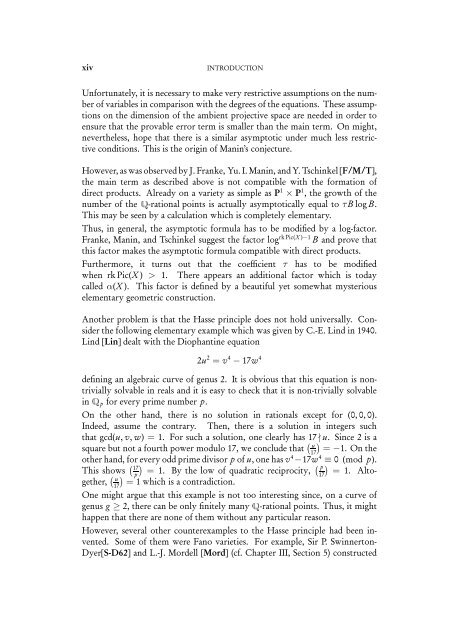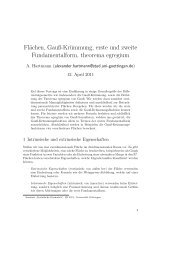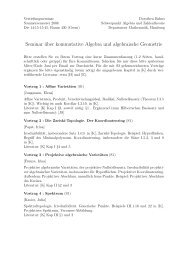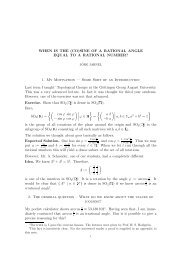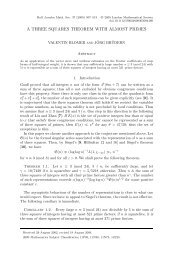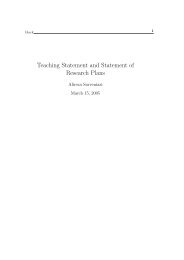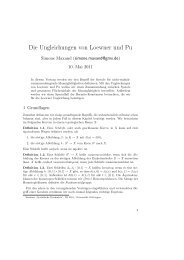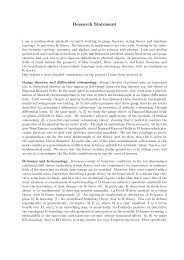- Page 1 and 2: BRAUER GROUPS, TAMAGAWA MEASURES, A
- Page 3: BRAUER GROUPS, TAMAGAWA MEASURES, A
- Page 6 and 7: iv CONTENTS 8. Examples . . .......
- Page 8 and 9: vi CONTENTS 4. Results . . ........
- Page 10 and 11: viii NOTATION AND FUNDAMENTAL CONVE
- Page 13 and 14: INTRODUCTION Here, in the midst of
- Page 15: INTRODUCTION xiii many rational poi
- Page 19 and 20: INTRODUCTION xvii from central simp
- Page 21 and 22: INTRODUCTION xix generating Brauer
- Page 23 and 24: INTRODUCTION xxi by Yuri Bilu [Bilu
- Page 25: INTRODUCTION xxiii X might be a can
- Page 29 and 30: CHAPTER I THE BRAUER-SEVERI VARIETY
- Page 31 and 32: Sec. 2] NON-ABELIAN GROUP COHOMOLOG
- Page 33 and 34: Sec. 2] NON-ABELIAN GROUP COHOMOLOG
- Page 35 and 36: Sec. 3] GALOIS DESCENT 9 ⎧ ⎫
- Page 37 and 38: Sec. 3] GALOIS DESCENT 11 is G-inva
- Page 39 and 40: Sec. 3] GALOIS DESCENT 13 Hence, x
- Page 41 and 42: Sec. 3] GALOIS DESCENT 15 r L : A
- Page 43 and 44: Sec. 3] GALOIS DESCENT 17 of cohere
- Page 45 and 46: Sec. 3] GALOIS DESCENT 19 of a fiel
- Page 47 and 48: Sec. 3] GALOIS DESCENT 21 = = l ∑
- Page 49 and 50: Sec. 4] CENTRAL SIMPLE ALGEBRAS AND
- Page 51 and 52: Sec. 4] CENTRAL SIMPLE ALGEBRAS AND
- Page 53 and 54: Sec. 4] CENTRAL SIMPLE ALGEBRAS AND
- Page 55 and 56: Sec. 5] BRAUER-SEVERI VARIETIES AND
- Page 57 and 58: Sec. 5] BRAUER-SEVERI VARIETIES AND
- Page 59 and 60: Sec. 5] BRAUER-SEVERI VARIETIES AND
- Page 61 and 62: Sec. 6] CENTRAL SIMPLE ALGEBRAS AND
- Page 63 and 64: Sec. 6] CENTRAL SIMPLE ALGEBRAS AND
- Page 65 and 66: Sec. 7] FUNCTORIALITY 39 7. Functor
- Page 67 and 68:
Sec. 7] FUNCTORIALITY 41 we will de
- Page 69 and 70:
Sec. 7] FUNCTORIALITY 43 7.9. Defin
- Page 71 and 72:
Sec. 7] FUNCTORIALITY 45 such that
- Page 73 and 74:
Sec. 7] FUNCTORIALITY 47 on the pro
- Page 75 and 76:
Sec. 7] FUNCTORIALITY 49 We put X /
- Page 77 and 78:
Sec. 7] FUNCTORIALITY 51 For σ ∈
- Page 79 and 80:
Sec. 8] THE FUNCTOR OF POINTS 53 By
- Page 81 and 82:
Sec. 8] THE FUNCTOR OF POINTS 55 8.
- Page 83 and 84:
Sec. 8] THE FUNCTOR OF POINTS 57 Pr
- Page 85 and 86:
Sec. 8] THE FUNCTOR OF POINTS 59 As
- Page 87 and 88:
CHAPTER II ON THE BRAUER GROUP OF A
- Page 89 and 90:
Sec. 1] AZUMAYA ALGEBRAS 63 It is c
- Page 91 and 92:
Sec. 2] THE BRAUER GROUP 65 of Azum
- Page 93 and 94:
Sec. 3] THE COHOMOLOGICAL BRAUER GR
- Page 95 and 96:
Sec. 3] THE COHOMOLOGICAL BRAUER GR
- Page 97 and 98:
Sec. 4] THE RELATION TO THE BRAUER
- Page 99 and 100:
Sec. 4] THE RELATION TO THE BRAUER
- Page 101 and 102:
Sec. 5] THE BRAUER GROUP AND THE CO
- Page 103 and 104:
Sec. 6] ORDERS IN CENTRAL SIMPLE AL
- Page 105 and 106:
Sec. 6] ORDERS IN CENTRAL SIMPLE AL
- Page 107 and 108:
Sec. 6] ORDERS IN CENTRAL SIMPLE AL
- Page 109 and 110:
Sec. 6] ORDERS IN CENTRAL SIMPLE AL
- Page 111 and 112:
Sec. 7] THE THEOREM OF AUSLANDER AN
- Page 113 and 114:
Sec. 8] EXAMPLES 87 ii) Denote by r
- Page 115 and 116:
Sec. 8] EXAMPLES 89 Altogether, the
- Page 117 and 118:
Sec. 8] EXAMPLES 91 In addition, if
- Page 119 and 120:
Sec. 8] EXAMPLES 93 iv. Manin’s f
- Page 121 and 122:
Sec. 8] EXAMPLES 95 If is well know
- Page 123:
Sec. 8] EXAMPLES 97 8.26. Remark. -
- Page 126 and 127:
100 AN APPLICATION: THE BRAUER-MANI
- Page 128 and 129:
)É 102 AN APPLICATION: THE BRAUER-
- Page 130 and 131:
104 AN APPLICATION: THE BRAUER-MANI
- Page 132 and 133:
106 AN APPLICATION: THE BRAUER-MANI
- Page 134 and 135:
108 AN APPLICATION: THE BRAUER-MANI
- Page 136 and 137:
110 AN APPLICATION: THE BRAUER-MANI
- Page 138 and 139:
112 AN APPLICATION: THE BRAUER-MANI
- Page 140 and 141:
114 AN APPLICATION: THE BRAUER-MANI
- Page 142 and 143:
116 AN APPLICATION: THE BRAUER-MANI
- Page 144 and 145:
118 AN APPLICATION: THE BRAUER-MANI
- Page 146 and 147:
=/3 120 AN APPLICATION: THE BRAUER-
- Page 148 and 149:
122 AN APPLICATION: THE BRAUER-MANI
- Page 150 and 151:
124 AN APPLICATION: THE BRAUER-MANI
- Page 152 and 153:
126 AN APPLICATION: THE BRAUER-MANI
- Page 154 and 155:
128 AN APPLICATION: THE BRAUER-MANI
- Page 156 and 157:
130 AN APPLICATION: THE BRAUER-MANI
- Page 158 and 159:
132 AN APPLICATION: THE BRAUER-MANI
- Page 160 and 161:
134 AN APPLICATION: THE BRAUER-MANI
- Page 162 and 163:
136 AN APPLICATION: THE BRAUER-MANI
- Page 164 and 165:
138 AN APPLICATION: THE BRAUER-MANI
- Page 166 and 167:
140 AN APPLICATION: THE BRAUER-MANI
- Page 168 and 169:
142 AN APPLICATION: THE BRAUER-MANI
- Page 170 and 171:
144 AN APPLICATION: THE BRAUER-MANI
- Page 173:
PART B HEIGHTS
- Page 176 and 177:
150 THE CONCEPT OF A HEIGHT [Chap.
- Page 178 and 179:
152 THE CONCEPT OF A HEIGHT [Chap.
- Page 180 and 181:
154 THE CONCEPT OF A HEIGHT [Chap.
- Page 182 and 183:
156 THE CONCEPT OF A HEIGHT [Chap.
- Page 184 and 185:
158 THE CONCEPT OF A HEIGHT [Chap.
- Page 186 and 187:
160 THE CONCEPT OF A HEIGHT [Chap.
- Page 188 and 189:
162 THE CONCEPT OF A HEIGHT [Chap.
- Page 190 and 191:
164 THE CONCEPT OF A HEIGHT [Chap.
- Page 192 and 193:
166 THE CONCEPT OF A HEIGHT [Chap.
- Page 194 and 195:
168 THE CONCEPT OF A HEIGHT [Chap.
- Page 196 and 197:
É)⊗ÉÊ 170 THE CONCEPT OF A HEI
- Page 198 and 199:
172 THE CONCEPT OF A HEIGHT [Chap.
- Page 200 and 201:
174 THE CONCEPT OF A HEIGHT [Chap.
- Page 202 and 203:
176 THE CONCEPT OF A HEIGHT [Chap.
- Page 204 and 205:
178 THE CONCEPT OF A HEIGHT [Chap.
- Page 206 and 207:
180 THE CONCEPT OF A HEIGHT [Chap.
- Page 208 and 209:
182 THE CONCEPT OF A HEIGHT [Chap.
- Page 210 and 211:
Ê 184 THE CONCEPT OF A HEIGHT [Cha
- Page 212 and 213:
186 THE CONCEPT OF A HEIGHT [Chap.
- Page 214 and 215:
→Ê 188 THE CONCEPT OF A HEIGHT [
- Page 216 and 217:
190 DISTRIBUTION OF SMALL POINTS [C
- Page 218 and 219:
192 DISTRIBUTION OF SMALL POINTS [C
- Page 220 and 221:
194 DISTRIBUTION OF SMALL POINTS [C
- Page 222 and 223:
196 DISTRIBUTION OF SMALL POINTS [C
- Page 224 and 225:
198 DISTRIBUTION OF SMALL POINTS [C
- Page 226 and 227:
200 DISTRIBUTION OF SMALL POINTS [C
- Page 228 and 229:
202 DISTRIBUTION OF SMALL POINTS [C
- Page 230 and 231:
204 DISTRIBUTION OF SMALL POINTS [C
- Page 232 and 233:
206 DISTRIBUTION OF SMALL POINTS [C
- Page 234 and 235:
208 DISTRIBUTION OF SMALL POINTS [C
- Page 236 and 237:
210 DISTRIBUTION OF SMALL POINTS [C
- Page 238 and 239:
212 CONJECTURES ON POINTS OF BOUNDE
- Page 240 and 241:
214 CONJECTURES ON POINTS OF BOUNDE
- Page 242 and 243:
216 CONJECTURES ON POINTS OF BOUNDE
- Page 244 and 245:
)⊗Ê 218 CONJECTURES ON POINTS OF
- Page 246 and 247:
220 CONJECTURES ON POINTS OF BOUNDE
- Page 248 and 249:
222 CONJECTURES ON POINTS OF BOUNDE
- Page 250 and 251:
224 CONJECTURES ON POINTS OF BOUNDE
- Page 252 and 253:
∈ 226 CONJECTURES ON POINTS OF BO
- Page 254 and 255:
228 CONJECTURES ON POINTS OF BOUNDE
- Page 256 and 257:
230 CONJECTURES ON POINTS OF BOUNDE
- Page 258 and 259:
232 CONJECTURES ON POINTS OF BOUNDE
- Page 260 and 261:
234 CONJECTURES ON POINTS OF BOUNDE
- Page 262 and 263:
236 CONJECTURES ON POINTS OF BOUNDE
- Page 264 and 265:
238 CONJECTURES ON POINTS OF BOUNDE
- Page 266 and 267:
240 CONJECTURES ON POINTS OF BOUNDE
- Page 269 and 270:
CHAPTER VII POINTS OF BOUNDED HEIGH
- Page 271 and 272:
Sec. 1] INTRODUCTION — MANIN’S
- Page 273 and 274:
Sec. 2] COMPUTING THE TAMAGAWA NUMB
- Page 275 and 276:
Sec. 2] COMPUTING THE TAMAGAWA NUMB
- Page 277 and 278:
Sec. 2] COMPUTING THE TAMAGAWA NUMB
- Page 279 and 280:
Sec. 3] ON THE GEOMETRY OF DIAGONAL
- Page 281 and 282:
Sec. 4] ACCUMULATING SUBVARIETIES 2
- Page 283 and 284:
Sec. 4] ACCUMULATING SUBVARIETIES 2
- Page 285 and 286:
Sec. 5] RESULTS 259 5. Results i. A
- Page 287 and 288:
Sec. 5] RESULTS 261 The statistical
- Page 289:
Sec. 5] RESULTS 263 TABLE 4. Parame
- Page 292 and 293:
266 ON THE SMALLEST POINT ON A DIAG
- Page 294 and 295:
268 ON THE SMALLEST POINT ON A DIAG
- Page 296 and 297:
270 ON THE SMALLEST POINT ON A DIAG
- Page 298 and 299:
272 ON THE SMALLEST POINT ON A DIAG
- Page 300 and 301:
274 ON THE SMALLEST POINT ON A DIAG
- Page 302 and 303:
276 ON THE SMALLEST POINT ON A DIAG
- Page 304 and 305:
278 ON THE SMALLEST POINT ON A DIAG
- Page 307 and 308:
CHAPTER IX GENERAL CUBIC SURFACES
- Page 309 and 310:
Sec. 1] RATIONAL POINTS ON CUBIC SU
- Page 311 and 312:
Sec. 2] BACKGROUND 285 These are st
- Page 313 and 314:
Sec. 3] THE GALOIS OPERATION ON THE
- Page 315 and 316:
Sec. 3] THE GALOIS OPERATION ON THE
- Page 317 and 318:
Sec. 4] COMPUTATION OF PEYRE’S CO
- Page 319 and 320:
Sec. 5] NUMERICAL DATA 293 of τ. (
- Page 321 and 322:
Sec. 5] NUMERICAL DATA 295 2.5 2.5
- Page 323 and 324:
Sec. 6] A CONCRETE EXAMPLE 297 6. A
- Page 325 and 326:
Sec. 6] A CONCRETE EXAMPLE 299 TABL
- Page 327 and 328:
CHAPTER X ON THE SMALLEST POINT ON
- Page 329 and 330:
Sec. 1] INTRODUCTION 303 1.4. Quest
- Page 331 and 332:
Sec. 2] THE FACTORS α AND β 305 2
- Page 333 and 334:
Sec. 3] SPLITTING THE PICARD GROUP
- Page 335 and 336:
Sec. 3] SPLITTING THE PICARD GROUP
- Page 337 and 338:
Sec. 5] A NEGATIVE RESULT 311 Denot
- Page 339 and 340:
Sec. 5] A NEGATIVE RESULT 313 There
- Page 341 and 342:
Sec. 5] A NEGATIVE RESULT 315 Recal
- Page 343 and 344:
Sec. 6] THE FUNDAMENTAL FINITENESS
- Page 345 and 346:
Sec. 6] THE FUNDAMENTAL FINITENESS
- Page 347 and 348:
Sec. 6] THE FUNDAMENTAL FINITENESS
- Page 349 and 350:
Sec. 6] THE FUNDAMENTAL FINITENESS
- Page 351 and 352:
Sec. 6] THE FUNDAMENTAL FINITENESS
- Page 353 and 354:
Sec. 6] THE FUNDAMENTAL FINITENESS
- Page 355 and 356:
CHAPTER XI THE DIOPHANTINE EQUATION
- Page 357 and 358:
Sec. 2] CONGRUENCES 331 For other p
- Page 359 and 360:
Sec. 4] AN ALGORITHM TO EFFICIENTLY
- Page 361 and 362:
Sec. 5] GENERAL FORMULATION OF THE
- Page 363 and 364:
Sec. 6] IMPROVEMENTS I - MORE CONGR
- Page 365 and 366:
Sec. 6] IMPROVEMENTS I - MORE CONGR
- Page 367 and 368:
Sec. 7] IMPROVEMENTS II - ADAPTION
- Page 369 and 370:
Sec. 7] IMPROVEMENTS II - ADAPTION
- Page 371 and 372:
Sec. 7] IMPROVEMENTS II - ADAPTION
- Page 373 and 374:
Sec. 7] IMPROVEMENTS II - ADAPTION
- Page 375 and 376:
CHAPTER XII NEW SUMS OF THREE CUBES
- Page 377 and 378:
Sec. 4] RESULTS 351 We start theLLL
- Page 379 and 380:
APPENDIX Diophantus, with this name
- Page 381 and 382:
APPENDIX 355 # Computation of NS \c
- Page 383 and 384:
APPENDIX 357 33 #U = 6 [ 2 ], #H^1
- Page 385 and 386:
APPENDIX 359 163 #U = 24 [ 2 ], #H^
- Page 387:
APPENDIX 361 293 #U = 120 [ 2 ], #H
- Page 390 and 391:
364 BIBLIOGRAPHY [ArE27a] [ArE27b]
- Page 392 and 393:
ÓÖÚÕ¸ºÁºÖÚÕ¸ÁºÊºÌ
- Page 394 and 395:
368 BIBLIOGRAPHY [C/L/R] [Cor] [C/S
- Page 396 and 397:
370 BIBLIOGRAPHY [Fa92] [F/P] [Fo]
- Page 398 and 399:
372 BIBLIOGRAPHY [Herm] [Hers] [Heu
- Page 400 and 401:
374 BIBLIOGRAPHY [Lan86] [Lan93] [L
- Page 402 and 403:
376 BIBLIOGRAPHY [Mori] [Mu-e] [Mu-
- Page 404 and 405:
378 BIBLIOGRAPHY [Sal80] [Sal81] [S
- Page 406 and 407:
380 BIBLIOGRAPHY [Sm] Smart, N. P.:
- Page 408 and 409:
382 BIBLIOGRAPHY [War] [We48] Warne
- Page 410 and 411:
384 INDEX linearly equivalent to ze
- Page 412 and 413:
386 INDEX elliptic cone . . . . . .
- Page 414 and 415:
388 INDEX Kühn, U. . . . . . . . .
- Page 416 and 417:
390 INDEX quadratic reciprocity low
- Page 418:
392 INDEX V valuation archimedean .


